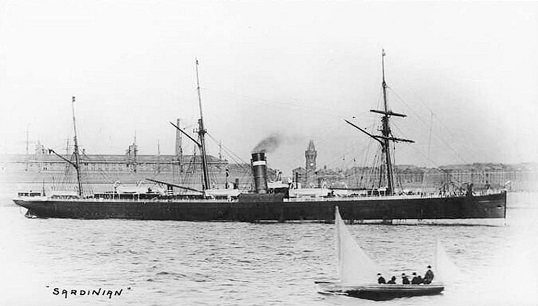Sardinian

The build
Sardinian was built for a Glasgow-based company, Allan Line, and the 4,375grt single-screw steamer was launched at Robert Steel & Company's Cartsburn Shipyard in June 1874.
The steamship was powered by a single two-cylinder compound engine rated at 600hp, was fitted with three masts and was capable of 13 knots. Sardinian could carry up to 120 first class passengers and 850 third class passengers.
Deployments
Sardinian set sail from Liverpool to Quebec and Montreal in July 1875 for its maiden voyage.
As well as running the Royal Mail service to Canada, Allan Line also had a contract with the Canadian government to carry emigrants and many of Sardinian's passengers were on assisted passages.
After the explosion in 1878, the Sardinian went on to set an Atlantic crossing record of six days and 23 hours in June 1879 and carried Canadian troops to the Boer war in South Africa in 1899.
Two years later, the ship took Guglielmo Marconi and his equipment to St John's, Newfoundland, where he set up a wireless station and made the first transatlantic radio transmissions.
Sardinian Fact File
How big was the Sardinian?
The Sardinian had a grt of 4,375.
When was the Sardinian launched?
The Sardinian was launched in 1874.
What was the Atlantic crossing record set by the Sardinian?
The Sardinian set a six days and 23 hours record for crossing the Atlantic in June 1879.
What year did the Sardinian end its service?
The Sardinian ended its service in June 1938 when it was sold for scrapping.
Explosion of 1878
In May 1878, one day after leaving the port of Liverpool bound for Canada, the Sardinian suffered a devastating coal bunker explosion while at anchor in Lough Foyle, near the port of Moville.
One of the passengers onboard was Captain J.J. Grylls, the secretary of Nautilus International predecessor organisation the Mercantile Marine Service Association. He was sailing to Derry on a pleasure trip and was on the bridge at the time of blast.
He told how 'people came shrieking up the companion ways, many of them cut, bruised and blackened' and that a 'great deal of confusion was caused by the separation of the children from parents and husbands from wives. One poor woman begged me to go and find her baby, which was torn from her arms.'
Capt Grylls praised the 'extraordinary exertions' of the ship's master, officers and crew in fighting the fire, helping to save several people 'who were in the midst of the debris' and transferring survivors to rescue vessels. Four passengers died and more than 40 suffered serious injuries.
The ship was scuttled in five fathoms of water but was subsequently recovered and repaired, returning to service by the end of June.
A Board of Trade enquiry ruled that the accident was the result of an explosion of coal and gas, which had been allowed to accumulate in the unventilated lower tween decks of the main hold. The Wreck Commissioner decided to take no action against the owners stating that no charge of negligence had been proved.
Ownership
In 1917, the vessel joined the Canadian Pacific fleet and spent three years with the company before sale to the Spanish company Astoreca Azqueta and service as a coal hulk in the port of Vigo.
The ship was sold again in 1934 to the bunkering firm Company Carbonera and in June 1938 was sold for scrapping at Bilbao.
Contribute
Are you knowledgeable about this vessel?
Submit your contribution to this article to our editorial team.
Write to usView more ships of the past
HMS Beagle
Launched 200 years ago, HMS Beagle has been described as one of the most important ships in history – thanks to the observations on evolution and natural selection that its famous passenger Charles Darwin made during a five-year voyage around the world between 1831 and 1836.
Common.ReadMoreHMS Beagle
Megara
Originally constructed as an oil tanker in 1929, the Dutch ship Megara went on to become one of the first specialist liquefied petroleum gas (LPG) carriers only five years later.
Common.ReadMoreMegara
Malakand
Launched in November 1918, the Malakand was a sistership to three other vessels and was fitted to train cadets until the shipping slump of the 1920s. With an uneventful early career, the Malakand later became the victim of Liverpool's May Blitz in 1941.
Common.ReadMore